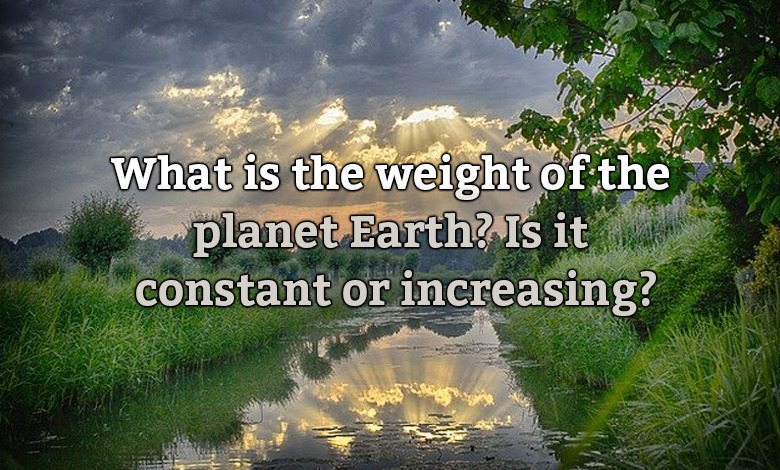Our planet is suspended in space, which means that its weight would differ in different gravitational fields. For example, in Earth’s gravitational field some object weighs, say, 1 kilogram, but the same object on the Moon (i.e. in the Moon’s gravitational field) would weigh 1/6 of its weight on the Earth. That is the reason the weight of the planet can’t be talked about nor calculated, as it requires a gravitational field to determine weight. The mass remains the same.
Instead of the weight, it’s more appropriate to discuss the mass of the planet Earth. This is approximately 6E+24 (Six followed by twenty four zeros!) kilograms.
However, you will be surprised to know that the weight of our planet increases approximately by 20,000 to 30,000 tons a year!
Being in swift motion in space, the Earth attracts space dust, little special objects and falling stars into its atmosphere with its gravitational force. Even if these objects burn out due to the friction of the atmosphere, their ashes keep on adding a good amount of weight every day. Still, this quantity being added is nothing in relation to the total weight of the planet.
Getting the Answer
So how did anyone arrive at the answer to the question of how much the Earth weighs? We can’t weigh the Earth on a scale, but we can look at the gravitational pull of our planet.
Basically, if two masses are put together, they will have some sort of gravitational pull towards one another. We can see this by putting a couple of bowling balls side by side and seeing how they gravitate towards each other. Of course, the attraction here is very light and might not be noticed by the naked eye. However, we can still measure that slight attraction if we have the right instruments on hand.
Measuring the amount of attraction from one object to another can help us determine their weight. Isaac Newton showed us that spherical objects have all of their mass concentrated at their center. Since our planet Earth is also a sphere, the same holds true for it as well.
We can use the following equation to calculate the gravitational attraction between two spherical objects:
F = G (M1*M2/R2)
Here, F denoted the force of traction between the two objects. G is the constant and is equal to 6.67259 x 10-11 m3/kg s2. M1 and M2 denote the masses in question.
We can assume that the planet Earth is M1 and a sphere weighing 1 kilo is M2. We can drop the small sphere to the ground and measure the acceleration that occurs when Earth’s gravity acts upon it. This will probably be around 9.8m/s2. We also know that the Earth’s radius measures 6,400,000 meters or 6,999,125 yards.
Now that we have all the values except M1, we can plus them into the equation and solve it to get the mass of Earth. The answer will be 6,000,000,000, 000,000,000,000,000 kilograms.
More reading:
- Earth (Wikipedia)
